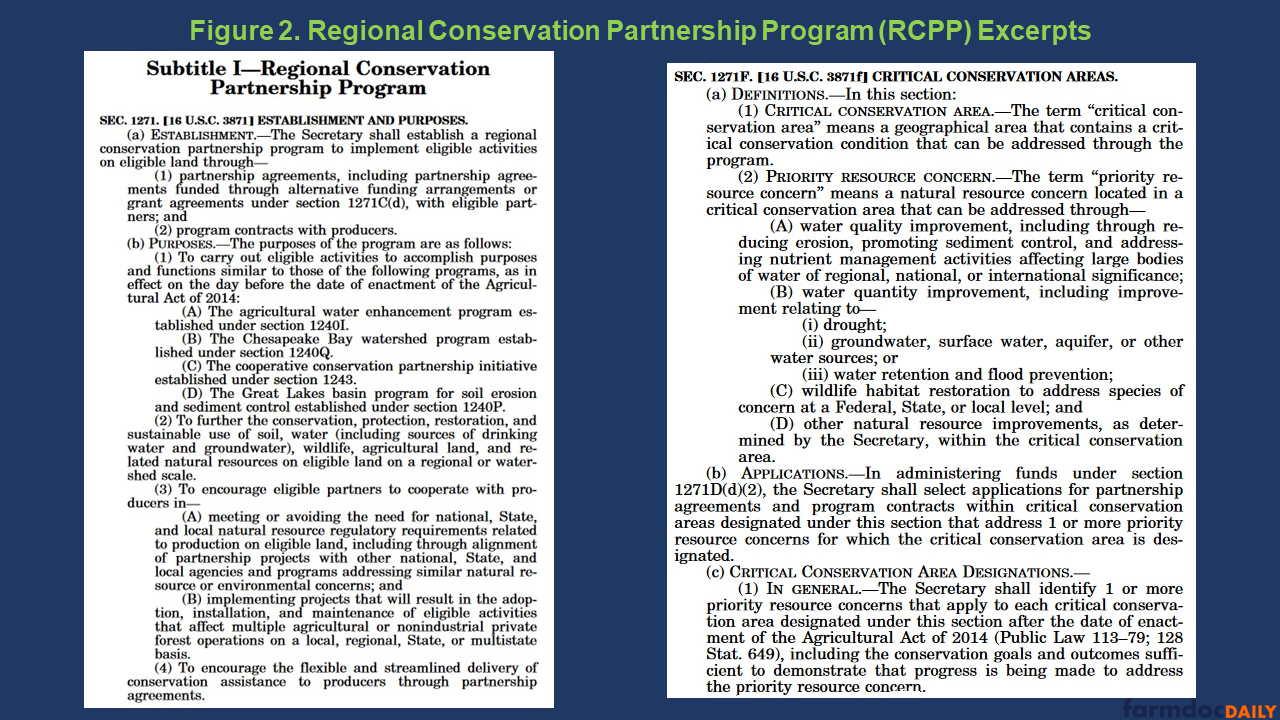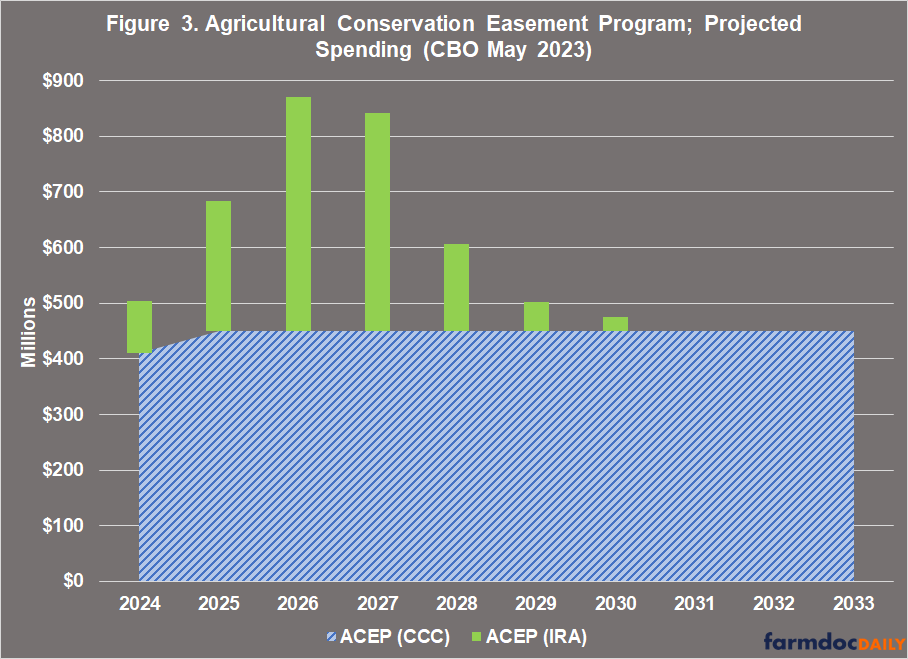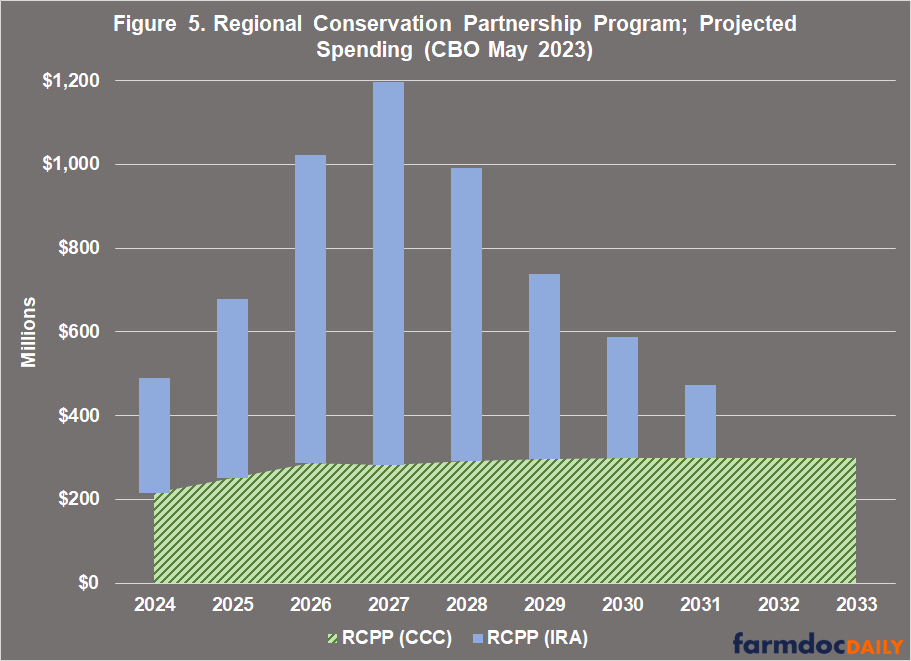A View of the Farm Bill Through Policy Design, Part 7: ACEP and RCPP
Water. While there are few more vital natural resources, there is not one that presents quite the same paradox; we need water to survive, but too much water can kill. Despite its crucial role, we consume water recklessly. We too often pollute it or take it for granted, even as we rely on it for life and our myriad pursuits of happiness (see e.g., Robbins, September 12, 2023; Searcy, Rojanasakul, and Guttenfelder, September 3, 2023; Rojanasakul et al., August 28, 2023; Moyer, July 28, 2023; Robbins, July 11, 2023; Christensen, July 6, 2023; Zhong, June 6, 2023; Einhorn, April 3, 2023; Flavell and Rojanasakul, January 31, 2023; Koch, December 26, 2022; Rothberg, August 4, 2022). It is with water on the mind at this portentous time that this article rounds out the first stage of work on the Conservation Title of the Farm Bill (Hausfather, October 13, 2023; farmdoc daily, September 21, 2023; May 11, 2023; April 13, 2023).
Background
The Agriculture Conservation Easement Program (ACEP) was created by Congress in the Agricultural Act of 2014 by combining existing easement programs into a single authorization (P.L. 113-79). The combined program works through two subprograms. The first is Agricultural Land Easements (ALE), which protect natural resources and agricultural uses, allowing the landowner to continue to farm the land (16 U.S.C. §3865b). These easements are generally designed to protect farmland from development pressures, such as from sprawling suburbs and exurbs. The second subprogram is the Wetland Reserve Easement (WRE), which assists landowners with restoring or maintaining a restored wetland on the farm (16 U.S.C. §3865c). In general, a conservation easement is a permanent (or long-term) property right on the land that the landowner agrees to transfer to the government agency or a nonprofit entity. That property right is transferred in return for some financial benefit and for the purposes of achieving conservation goals, such as restoring a wetland (see e.g., Phelps, 2023). Figure 1 provides excerpts of ACEP authorities from the compilation available from the Senate Committee on Agriculture, Nutrition, and Forestry (ANF) (Senate ANF, Compilation: Food Security Act of 1985).
Congress created the Regional Conservation Partnership Program (RCPP) in the 2014 Farm Bill to work across different conservation program authorities, combine conservation practices and farms in a regional approach, and to bring in non-federal contributions from private partners (P.L. 113-79). Congress revised the program in the 2018 Farm Bill to improve its operation (P.L. 115-334). What distinguishes RCPP begins with the regional focus, seeking coordination of conservation efforts across multiple farms such as those in a watershed. Congress also intended for the program to use the basic conservation authorities of multiple programs, although with the changes in 2018 the program authorities are less explicit, and it incorporates a multitude of conservation practices. Most notable, however, is the fact that RCPP leverages private resources from companies, nonprofit or other entities. Private partners bring funding as well as expertise and administrative capacity with the intent that doing so will to help advance conservation efforts more effectively and efficiently (16 U.S.C. §§3871-3871f). Figure 2 presents excerpts of RCPP authorities from the Senate ANF compilation (Senate ANF, Compilation: Food Security Act of 1985).
Discussion
ACEP and RCPP make up roughly 7.5% and 4.7% (respectively) of total conservation spending in the Congressional Budget Office May 2023 baseline (CBO, May 2023). Both programs also received significant additional funding in the Inflation Reduction Act of 2022. According to CBO, ACEP received nearly 8% of the total additional appropriations for the conservation programs and is estimated to constitute nearly 9% of the total additional outlays. By comparison, RCPP received 27% of the total additional appropriation and is projected to spend nearly 25% of the total additional outlays from the Inflation Reduction Act investments in conservation programs (includes the Environmental Quality Incentives Program and the Conservation Stewardship Program).
Figure 3 illustrates the projected spending for ACEP from the Commodity Credit Corporation (CCC) funds as authorized in the Farm Bill (blue striped area) and from the Inflation Reduction Act (light green bars). The baseline for ACEP is $450 million each fiscal year and the additional spending is projected to peak at $421 million in fiscal year 2026 and conclude in FY 2031 with the program reverting to the baseline for the final two fiscal years.
As noted above, ACEP works through easements—permanent or long-term property rights—to protect farmland from development pressure and to restore wetlands. Arguably, the leading institutional voice on protecting farmland is the American Farmland Trust and the organization recently released a comprehensive report titled “Farms Under Threat 2040: Choosing an Abundant Future” (AFT, Farms Under Threat, June 29, 2022). The report is accompanied by an interactive mapping tool, climate and other modeling efforts, as well as webinars. The ALE portion of ACEP is a critical tool in protecting farmland.
ACEP also contains assistance to restore wetlands on farms through the WRE subprogram, which assumed the efforts originally authorized in the 1990 Farm Bill as the Wetlands Reserve Program (WRP) (P.L. 101-624). Wetlands provide critical natural resource benefits, especially for water, and are considered “nature’s kidneys” (Karwowski and Skidmore, April 2023). They filter out sediments and excess nutrients, as well as helping control the flow of surface water. Wetlands can also provide habitat benefits for wildlife. Because of the benefits wetlands can provide, research has also found the potential for increases to crop yields where acreage in wetlands has been increased (Karwowski, 2022).
Figure 4 provides an interactive map of the financial assistance—the direct benefits paid to farmers and landowners—from ACEP as part of the Policy Design Lab project (https://policydesignlab.ncsa.illinois.edu/acep). The map presents total benefits from ACEP by state for fiscal years 2018 to 2022. Below the map is an interactive are a series of square diagrams known as tree maps which provide information by state as to the total benefits, acres, and number of contracts from FY2018 to FY2022.
Figure 4. Total ACEP Benefits from 2018-2022
RCPP is the newest conservation program in the Farm Bill having been added in 2014. It might also be the most ambitious with a regional focus, the combination of multiple conservation policy authorizations, and the inclusion of private partnership funding and efforts. Innovation comes with significant implementation and operational challenges as both farmers and agencies learn through the new program. With RCPP, private partners are also on the learning curve with farmers and NRCS employees (see e.g., Samanta et al, 2020). As one indicator of the potential for RCPP, Figure 5 illustrates the projected outlays by CBO. The CCC funds constitute the baseline (green striped area), with the additional investments from the Inflation Reduction Act (light blue bars) included. As with the other conservation programs that received additional investments, RCPP spending is projected to peak in FY2027 at nearly $1 billion and then return to the baseline levels ($300 million per FY) after FY2031.
Finally, Figure 6 is the interactive map for RCPP benefits (financial assistance) as part of the Policy Design Lab project (https://policydesignlab.ncsa.illinois.edu/rcpp). The total benefits for each State from FY2018 to FY2022, represents the assistance by the program as it was revised in the 2018 Farm Bill. Below the map is an interactive table of each state’s performance in the 2018 version of the program. Note that both the map and the table do not include the spending from the 2014 version of RCPP and will be updated as development continues.
Figure 6. Total RCPP Benefits from 2018-2022
Concluding Thoughts
The words of the statute determine the operation of policies and the distribution of benefits. The articles in this series explore the major mandatory titles, policies, and programs in the Farm Bill with updates on development of the Policy Design Lab, a web-based resource in which to explore and analyze existing policies and policy alternatives. Overall, the goal is to incorporate and apply research, publicly available data, and computational resources for analysis and visualization of federal agricultural policies with research and data guided by statutory provisions or legislative options to produce comparative analysis. For each of the major mandatory farm bill programs, the starting point is visualizing the status quo with maps and charts of the distribution of benefits and payments by State.
Today’s article reviewed the Agricultural Conservation Easement Program (ACEP) and the Regional Conservation Partnership Program (RCPP). While two of the smallest conservation programs in the Farm Bill, both represent valuable investments in protecting natural resources and preserving farmland. ACEP uses easements to restore and maintain wetlands, a kind of kidney transplant for the ecosystem, as well as to protect farmland under development pressures. RCPP presents an innovative approach to achieving conservation across landscape scales and with private partner contributions. Both received a significant boost from the Inflation Reduction Act and a renewed focus on conserving vital natural resources while also contributing to the efforts at addressing climate change. Important as these investments are, they also remain insufficient for the scale and scope of the challenges we face. A forward-looking farm bill that prioritized the public’s interest over narrow factional interests would build upon these small but important contributions.
References
Christensen, Jen. “Nearly half of the tap water in the US is contaminated with ‘forever chemicals,’ government study finds.” CNN.com. July 6, 2023. https://www.cnn.com/2023/07/05/health/pfas-nearly-half-us-tap-water-wellness/index.html.
Coppess, J. "A View of the Farm Bill Through Policy Design, Part 6: Conservation Reserve Program." farmdoc daily (13):172, Department of Agricultural and Consumer Economics, University of Illinois at Urbana-Champaign, September 21, 2023.
Coppess, J. and A. Knepp. "A View of the Farm Bill Through Policy Design, Part 2: CSP." farmdoc daily (13):86, Department of Agricultural and Consumer Economics, University of Illinois at Urbana-Champaign, May 11, 2023.
Coppess, J. and A. Knepp. "A View of the Farm Bill Through Policy Design, Part 1: EQIP." farmdoc daily (13):69, Department of Agricultural and Consumer Economics, University of Illinois at Urbana-Champaign, April 13, 2023.
Einhorn, Catrin. “California Salmon Stocks Are Crashing. A Fishing Ban Looks Certain.” The New York Times. April 3, 2023. https://www.nytimes.com/2023/04/03/climate/salmon-fishery-closed-california.html.
Flavelle, Christopher and Mira Rojanasakul. “As the Colorado River Shrinks, Washington Prepares to Spread the Pain.” The New York Times. January 31, 2023. https://www.nytimes.com/2023/01/27/climate/colorado-river-biden-cuts.html.
Hausfather, Zeke. “I Study Climate Change. The Data Is Telling Us Something New.” The New York Times. October 13, 2023. https://www.nytimes.com/2023/10/13/opinion/climate-change-excessive-heat-2023.html.
Karwowski, Nicole. Estimating the Effect of Easements on Agricultural Production. No. w30156. National Bureau of Economic Research, 2022. https://www.nber.org/papers/w30156
Karwowski, Nicole, and Marin Skidmore. “Nature’s Kidneys: the Role of the Wetland Reserve Program in Restoring Water Quality.” (2023). https://ageconsearch.umn.edu/record/335440/files/25953.pdf
Koch, Natalie. “Arizona Is in a Race to the Bottom of Its Water Wells, With Saudi Arabia’s Help.” The New York Times, December 26, 2022. https://www.nytimes.com/2022/12/26/opinion/arizona-water-colorado-river-saudi-arabia.html.
Moyer, Melinda Wenner. “Is That Water Too Polluted to Swim in?” The New York Times. July 28, 2023. https://www.nytimes.com/2023/07/28/well/live/water-contamination-beach-safety-swimming.html.
Phelps, Jess. “Understanding the Roles of Government in Conservation Easement Transactions.” Denver L. Rev. 100 (2022): 721.
Robbins, Jim. “’Zombie Trout’ Unsettle Montana, Long a Fly-Fishing Mecca.” The New York Times. September 12, 2023. https://www.nytimes.com/2023/09/12/science/trout-big-hole-river-climate-change.html.
Robbins, Jim. “Tracing Mining’s Threat to U.S. Waters.” The New York Times. July 11, 2023. https://www.nytimes.com/2023/07/11/science/us-canada-mining-pollution.html.
Rojanasakul, Mira, Christopher Flavelle, Blacki Migliozzi, and Eli Murray. “America Is Using Up Its Groundwater Like There’s No Tomorrow.” The New York Times, August 28, 2023. https://www.nytimes.com/interactive/2023/08/28/climate/groundwater-drying-climate-change.html.
Rothberg, Daniel. “The Coming Crisis Along the Colorado River.” The New York Times, August 4, 2022. https://www.nytimes.com/2022/08/04/opinion/drought-climate-colorado-river.html.
Samanta, Aritree, Francis R. Eanes, Benjamin Wickerham, Mary Fales, Brian R. Bulla, and Linda S. Prokopy. “Communication, Partnerships, and the Role of Social Science: Conservation Delivery in a Brave New World.” Society & Natural Resources 33, no. 7 (2020): 914-926. https://www.tandfonline.com/doi/full/10.1080/08941920.2019.1695990
Searcey, Dionne, Mira Rojanasakul, and David Guttenfelder. “Big Farms and Flawless Fries Are Gulping Water in the Land of 10,000 Lakes.” The New York Times. September 3, 2023. https://www.nytimes.com/2022/12/26/opinion/arizona-water-colorado-river-saudi-arabia.html.
Xie, Yanhua, Mitch Hunter, Ann Sorensen, Theresa Nogeire-McRae, Ryan Murphy, Justin P. Suraci, Stacy Lischka, and Tyler J. Lark. “US Farmland under Threat of Urbanization: Future Development Scenarios to 2040.” Land 12, no. 3 (2023): 574. https://www.mdpi.com/2073-445X/12/3/574 and https://farmlandinfo.org/publications/farms-under-threat-2040/.
Zhong, Raymond. “The Grand Canyon, a Cathedral to Time, Is Losing Its River.” The New York Times. June 6, 2023. https://www.nytimes.com/interactive/2023/06/06/climate/grand-canyon-colorado-river.html.
Disclaimer: We request all readers, electronic media and others follow our citation guidelines when re-posting articles from farmdoc daily. Guidelines are available here. The farmdoc daily website falls under University of Illinois copyright and intellectual property rights. For a detailed statement, please see the University of Illinois Copyright Information and Policies here.











